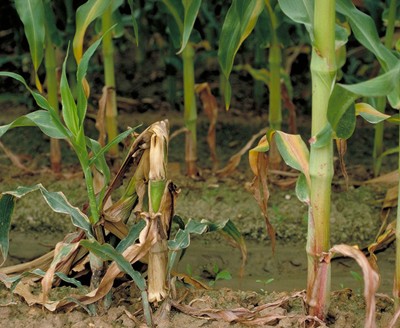 Stalk Rots
Stalk Rots
- Stalk rots cause yield loss through premature plant death, lightweight ears, and stalk lodging.
- Post-pollination stressors pre-dispose corn to stalk rots.
- Assess fields using push tests at R5.
- Prioritize harvest where risk of lodging is highest.
Stalk rots are the most commonly occurring disease/issue across the corn belt and affect every corn field to some degree. In years where plants are stressed from R1-R5, stalk rots and associated lodging issues can be a more pronounced issue. Now is a good time to review stalk rots and how to scout for these diseases. This article will review the basics of stalk rots and scouting.
What Favors Stalk Rots?
Stalk rots can cause yield loss in two primary ways: 1) directly through premature plant death and lightweight ears; and 2) indirectly through stalk lodging. Stalk rots are most troublesome when excellent growing conditions occur prior to VT , followed by stressful conditions from R1-R5. Good growing conditions prior to and during pollination typically result in high kernel set, especially with hybrids specifically developed for high yield. The large number of kernels then represents an enormous carbohydrate sink in the plant, requiring a large quantity of photosynthates to drive grain fill.
Any environmental stress that reduces photosynthesis in the post-pollination period can pre-dispose a corn plant to infection by most stalk rot pathogens. Such stressors include excessive plant populations, drought, heat stress, cloudy days, heavy foliar disease, insect feeding on leaves and roots, compaction, nutrient imbalances, stalk damage due to hail or insects, and under-developed root systems. After VT, the priority of the plant is successful reproduction, and during grain fill it mobilizes carbohydrates to the kernels to ensure reproductive success. If the plant cannot create enough carbohydrates from green tissues to both fill the kernels, the plant re-mobilize carbohydrates and nutrients from the roots and then stalk. This results in these tissues not having sufficient carbohydrates to support their own maintenance, facilitating the colonization of these tissues by stalk rot pathogens present within the soil and on soil residue.
How Can You Assess The Potential for Stalk Rot Problems?
Scout fields at R5.1 to black layer. Check 20 stalks in each of 5 locations (100 stalks total) across the field. Push the stalk at about chest level to about 30 degrees from vertical. If the stalk lodges or fails to return to vertical, score that as positive for stalk rot. For example, if you assess 100 plants total, and 25 do not return to total, that field has a stalk rot potential of 25%. Fields with more than 15% stalk rot potential at black layer should be prioritized for early harvest, weighing potential lodging losses against drying charges.
A Note on Top Dieback
This season there have been some reports of whole field, hybrid specific top dieback. In many cases, one hybrid is completely unaffected whereas another is showing senescence of the top of the plant across the field. It is important to not confuse this symptom with anthracnose top dieback. Anthracnose top dieback often occurs in areas of the field, and under inspection of the tops, salmon colored spore masses and black lesions on the stalk rind should be evdent. These symptoms will be evident if another factor is the root cause. Some hybrids will express symptoms of top dieback when suffering from severe heat/drought related issues during the season.
The Take Home Message
Many of the stresses that can impact most stalk rots are driven by the environment and mostly out of our control. However, that does not mean that we cannot impose management practices that can help reduce stalk rots. These practices include selecting hybrids with good stay green / stalk strength and drought tolerance ratings, following sound agronomic practices such as following the recommended planting rates for your region and ensuring adequate nutrition. Ensure that weeds are effectively managed. Finally, reduce foliar stresses such as insect and diseases if they become problematic from R1-R5. Practices that reduce diseases and pests, such as rotation, selection of resistant hybrids, residue management, and informed pesticide use can help reduce these issues.